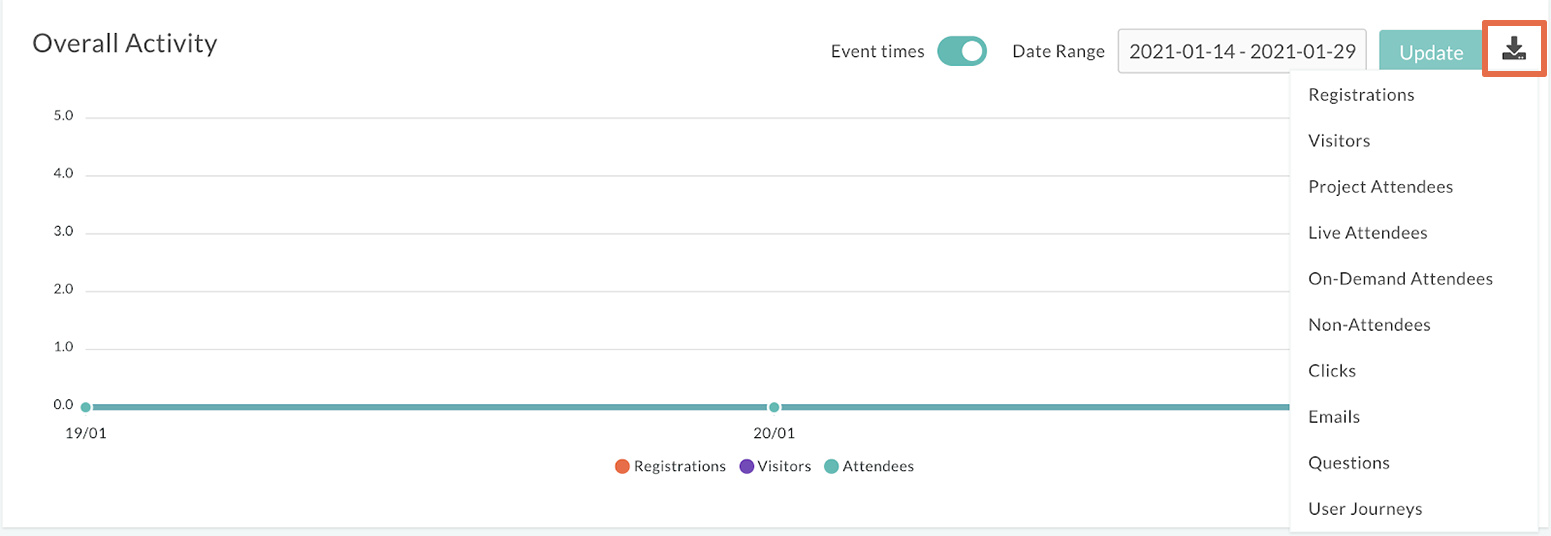Reporting - Attendees and Non-Attendees
In this guide we will walk you through how to view who attended your session, as well as how to view non-attendees.
 If you would like to download a report for all of your sessions, stay on the project report page. If you would like to get information on individual sessions, please select "Events" on the left hand side and select that particular event. Both options will then lead to the next step.
If you would like to download a report for all of your sessions, stay on the project report page. If you would like to get information on individual sessions, please select "Events" on the left hand side and select that particular event. Both options will then lead to the next step.
Navigate to the download icon towards the right hand side of the page, just next to update. You will then see a list of options. Depending on the data you would like to view, select one of the following:
- Project Attendees: This is the report to who attended your overall project. For example, those who logged onto the page and didn’t then progress onto watching your event.
- Live Attendees: This is the report to who watched your event at the time of first transmission whether your event is live, simulive or hybrid you can see all thoughts who watched it.
- On-Demand Attendees: This is the report to who is watching your on-demand content. Note that this will not apply if you have opted out of making your event available on demand once your live or simulive session has been broadcast.
- Non-Attendees: This is the report to who registered but did not attend your event during the initial live stream.


To help know what these referred to we will run through these below.
- User ID - This is the ID number given to each use
- First Name - This is the user's first name.
- Surname - This is the user's Surname.
- Email - This is the user's email address of which they have signed up with.
- Ticket Types - The Ticket Type(s) assigned to the user.
- Unsubscribed - This will show true or false depending on if the user has clicked unsubscribe to the registration email
- Uploaded - This is if the user has been manually uploaded into the system to appose of the user registering.
- Registered - This will tell you when the user registered for the event.
- Active - This will outline how long the user was active on your event page. This is measured by the page being the top view on the user's device. For example, if the user is watching and then minimises the page to check emails then they will no longer be active.
- Watching - This is how long the user has been playing the video. Unlike total active, this is measured throughout regardless of whether the video is in front view or not.
- First Active - This records when the user was first active on the project.
- Last Active - This records when the user was last active on the project.
- Engagement - This will allocate a score based on how engaged a user was with a project or event.
- Questions - This indicates whether a user has submitted any questions.
- Entry - This records how the user entered the video page.
- Referer - This records where the user may have come about knowing the page. For example, if they click an advert on Google which points to the event then Google would be the Referer.
- Referer Type - This is the type of referral for example if the user comes from a link within an advert on Google then that would be classed as a referral but if the user registered directly on the event page without via any other site then this would be classed as direct.
- Referer Data - This is any additional information from the referrer.
- IP Address - This is an Internet Protocol address which is a numerical label assigned to the device associated with each user.

